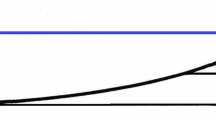Abstract
Certainly in river engineering design and planning studies, especially studies of rivers improvement, one of the challenges is prediction of stable cross-sectional hydraulic geometry in which the rate of erosion and sediment transport is in a regime state. In this study, an optimization–simulation model is developed to predict the response of alluvial bed rivers and design of their stable hydraulic geometry. The model contains an analytical model which is coupled with the imperialist competitive algorithm. Analytical simulation model uses the governing equations which describe the movement of water and sediment along the channel, calculate the distribution of the shear stresses and assess bank stability considering the effect of vegetation. Two hypotheses of maximum sediment transport capacity and minimum stream power are used as auxiliary equations to find the optimum dimensions of stable channel. The river channel responses predicted by the model are shown to agree with observations and empirical regime equations. Application of the imperialist competitive algorithm in a stable channel hydraulic geometry design reduces computational complexity and makes it possible to take into account more parameters with reasonably good results.















Similar content being viewed by others
References
Al Khaled A, Hosseini S (2015) Fuzzy adaptive imperialist competitive algorithm for global optimization. Neural Comput Appl 26(4):813–825
Atashpaz-Gargari E, Lucas C (2007) Imperialist competitive algorithm: an algorithm for optimization inspired by imperialistic competition. In: Proceedings of IEE congress on evolutionary computation, Singapore, pp 4661–4667
Bettess R, White WR (1987) Extremal hypotheses applied to river regime. In: Thorne CR, Bathurst JC, Hey RD (eds) Sediment transport in gravel-bed rivers. Wiley, Chichester, pp 767–792
Brown CB (1950) Sediment transportation. In: Rouse H (ed) Engineering hydraulics. Wiley, New York, pp 769–857
Chang HH (1979) Geometry of rivers in regime. J Hydraul Div ASCM 105(HY 6):691–706
Chow VT (1959) Open channel hydraulics. McGraw-Hill Co., New York
Enayatifar R, Yousefi M, Abdullah AH, Darus AN (2013) MOICA: a novel multi-objective approach based on imperialist competitive algorithm. Appl Math Comput 219(17):8829–8841
Ferguson RI (1986) Hydraulics and hydraulic geometry. Prog Phys Geogr 10:1–31
Flintham TP, Carling PA (1988) The prediction of mean bed and wall boundary shear in uniform and compositely roughened channels. In: White WP (ed) International conference on river regime. Wiley, New York, pp 267–287
Henderson FM (1966) Open channel flow. Macmillan Pub. Co., New York, pp 414–522
Hey RD, Thorne CR (1986) Stable channels with mobile gravel beds. J Hydraul Div (ASCE) 112(HY 8):671–689
Jain A, Bhattacharya RK, Sanaga S (2004) Optimal design of composite channels using genetic algorithm. J Irrig Drain Eng 130(4286):286–295
Janga Reddy M, Adarsh S (2010) Chance constrained optimal design of composite channels using meta-heuristic techniques. Water Resour Manag 24(10):2221–2235
Kaveh A, Talatahari S (2010) An improved ant colony optimization for constrained engineering design problems. Eng Comput 27(1):155–182
Keulegan GH (1938) Laws of turbulent flow in open channels. J Res Natl Bur Stand 21:707–741
Knight DW, Demetriou JD, Hamed ME (1984) Boundary shear in smooth rectangular channels. J Hydraul Div ASCE 110(HY 4):405–422
Lane E (1955) The Design of stable channels. Trans ASCE 120(2776):1234–1279
Lin JL, Cho CW, Chuan HC (2013) Imperialist competitive algorithms with perturbed moves for global optimization. Appl Mech Mater 284:3135–3139
Millar RG (2005) Theoretical regime equations for mobile gravel-bed rivers with stable banks. Geomorphology 64(3–4):207–220
Nourani V, Monadjemi P, Talatahari S, Shahradfar S (2009) Application of ant colony optimization to optimal design of open channels. J Hydraul Res 47(5):656–665
Orouji H, Mahmoudi N, Fallah-Mehdipour E, Pazoki M, Biswas A (2016) Shuffled frog-leaping algorithm for optimal design of open channels. J Irrig Drain Eng 142(10):06016008
Parsopoulos KE, Vrahatis MN (2002) Recent approaches to global optimization problems through particle swarm optimization. Nat Comput 1:235–306 (Kluwer Academic Publishers, Printed in the Netherlands)
Pourbaba M, Talatahari S, Sheikholeslami R (2013) A chaotic imperialist competitive algorithm for optimum cost design of cantilever retaining walls. KSCE J Civ Eng 17(5):972–979
Shaghaghi S, Bonakdari H, Gholami A, Ebtehaj I, Zeinolabedini M (2017) Comparative analysis of GMDH neural network based on genetic algorithm and particle swarm optimization in stable channel design. Appl Math Comput 313:271–286
Shields A (1936) Application of similarity principles and turbulence research to bed-load movement. California Institute of Technology, Pasadena
Talatahari S, Kaveh A, Sheikholeslami R (2012) Chaotic imperialist competitive algorithm for optimum design of truss structures. Struct Multidiscip Optim 46(3):355–367
Author information
Authors and Affiliations
Corresponding author
Rights and permissions
About this article
Cite this article
Majdzadeh Tabatabaei, M., Shourian, M. & Karimi, M. Optimum stable channel geometry design using imperialist competitive algorithm. Environ Earth Sci 77, 445 (2018). https://doi.org/10.1007/s12665-018-7634-9
Received:
Accepted:
Published:
DOI: https://doi.org/10.1007/s12665-018-7634-9




